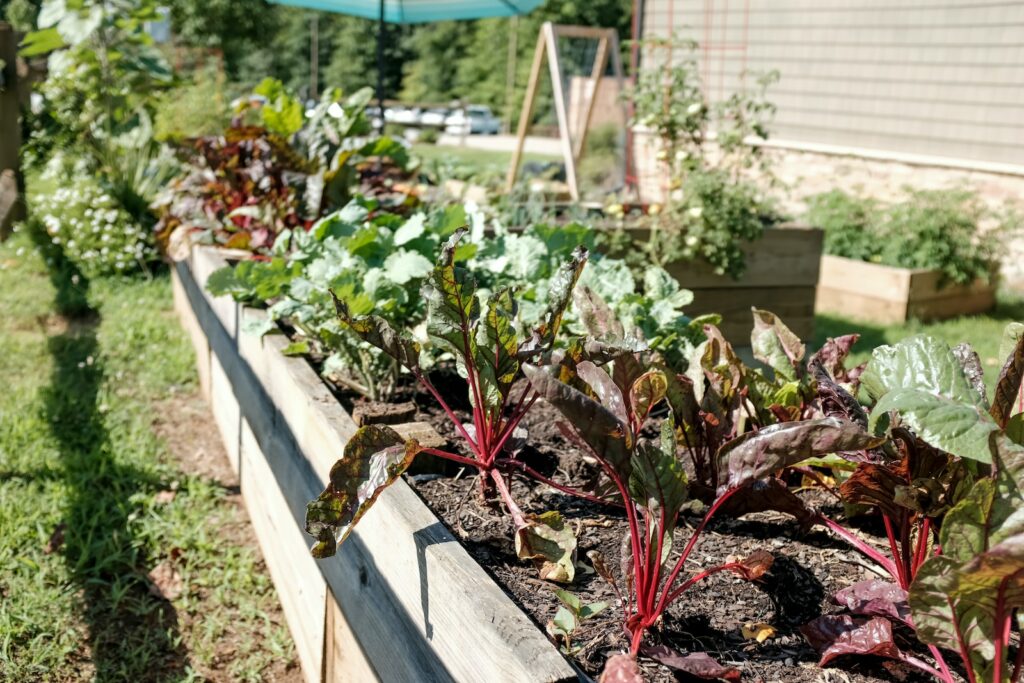Imagine stepping into your garden and being greeted by a feast for the senses—a picturesque landscape filled with vibrant flowers, lush foliage, and an array of edible delights.
Edible landscaping is a concept that allows you to grow your own food while creating a beautiful and functional outdoor space.
Whether you have a sprawling backyard or a small balcony, you can transform any area into a bountiful garden.
In this article, we will explore the art of edible landscaping and guide you through the process of growing your own food in a stunning garden.
Benefits of Edible Landscaping
Edible landscaping offers a multitude of benefits that extend beyond the satisfaction of harvesting your own produce. Let’s delve into some of the advantages that make it a compelling choice for garden enthusiasts.
A. Aesthetic Appeal and Functional Design
One of the remarkable aspects of edible landscaping is the ability to blend aesthetics with functionality. By integrating edible plants into your landscape, you create an eye-catching environment that stands out from traditional ornamental gardens.
The variety of colours, textures, and shapes offered by edible plants adds depth and visual interest to your garden.
Furthermore, with careful planning and design, you can create a functional space that maximizes the use of available land, allowing for both beauty and productivity.
B. Fresh and Nutritious Food at Your Fingertips
Perhaps the most enticing benefit of edible landscaping is the accessibility of fresh and nutritious food. Imagine plucking ripe tomatoes from a vine, harvesting fragrant herbs for your culinary creations, or biting into a juicy peach picked directly from a tree.
Edible landscaping eliminates the need for trips to the grocery store for certain fruits, vegetables, and herbs, ensuring a constant supply of homegrown goodness right in your backyard.
The satisfaction of eating food you’ve nurtured from seed to plate is unparalleled.
C. Environmental Sustainability and Cost Savings
Embracing edible landscaping aligns with a sustainable lifestyle and promotes environmental stewardship.
By growing your own food, you reduce your carbon footprint by minimizing transportation and packaging waste associated with store-bought produce.
Additionally, practising organic gardening methods minimizes the use of harmful chemicals, benefiting both your health and the environment.
Moreover, edible landscaping can result in cost savings over time. While there may be initial investments in landscape supplies and plants, the long-term savings from growing your own food can be substantial.
Selecting Suitable Edible Plants
Before embarking on your edible landscaping journey, it’s essential to select the right plants for your specific growing conditions and preferences.
A. Assessing Climate and Growing Conditions
Consider the climate and microclimate of your region, as well as the specific conditions of your garden, such as sunlight exposure, soil type, and drainage.
Auckland has a temperate maritime climate, characterized by mild winters and warm summers, making it suitable for a wide range of edible plants.
However, it’s crucial to choose varieties that thrive in your specific area within Auckland. Conduct research or consult with local garden centres or nurseries to identify plants that are well-adapted to the Auckland climate.
B. Choosing Varieties Based on Space and Preferences
Take into account the available space in your garden and choose plants that are appropriate for your area.
If you have limited space, consider compact or dwarf varieties, or explore vertical gardening techniques to make the most of your vertical space.
Additionally, consider your preferences when it comes to the types of fruits, vegetables, and herbs you enjoy.
Select varieties that align with your taste preferences and culinary interests, ensuring a delightful harvest that excites your palate.
C. Incorporating Perennial and Annual Plants
A well-planned edible landscape incorporates both perennial and annual plants. Perennial plants, such as fruit trees, berries, and certain herbs, provide a long-term investment in your garden.
They establish themselves over time and offer a consistent harvest year after year. Annual plants, on the other hand, provide an opportunity for seasonal variety and experimentation.
Vegetables, herbs, and annual fruits can be rotated each year to keep your garden fresh and exciting.
Designing Your Edible Landscape
Designing your edible landscape is a creative process that involves considering space, aesthetics, and functionality.
A. Considering Space and Layout
Assess the available space in your garden and plan the layout accordingly.
Take note of areas that receive the most sunlight and consider creating dedicated growing spaces for different types of plants. For example, plant taller trees or trellises on the northern side of your garden to avoid shading smaller plants.
Utilize raised beds, containers, or vertical structures to maximize space and create a visually appealing arrangement.
B. Companion Planting and Succession Planting
Companion planting is a technique where plants with mutually beneficial relationships are grown together.
Some plants repel pests, while others attract pollinators or enhance soil fertility. Research companion planting combinations that work well with the edible plants you have chosen.
Additionally, consider succession planting, which involves planting different crops in the same space at different times to ensure a continuous harvest throughout the growing season.
C. Incorporating Hardscape Elements
In addition to the plants themselves, hardscape elements can add structure and functionality to your edible landscape.
Consider including pathways, seating areas, or trellises for climbing plants. These elements not only enhance the visual appeal of your garden but also provide practicality and ease of maintenance.
Soil Preparation and Fertilization
Preparing your soil and ensuring its fertility are crucial steps in establishing a thriving edible garden.
A. Testing and Amending the Soil
Start by testing your soil to determine its composition, pH levels, and nutrient deficiencies. Soil testing kits and landscape supplies in Auckland are readily available at landscape supply stores.
Based on the results, you can amend the soil with organic matter, such as compost or well-rotted manure, to improve its structure and nutrient content. Add amendments to address any specific deficiencies identified in the soil test.
B. Organic Fertilizers and Composting
Organic fertilizers are excellent additions to support the growth of your edible plants. Look for natural fertilizers that are specifically formulated for edible gardens, ensuring they are free from synthetic chemicals.
Composting is another sustainable practice that enriches the soil. Start a compost pile using kitchen scraps, yard waste, and other organic matter.
Over time, the compost will break down into nutrient-rich humus that can be incorporated into your garden soil.
C. Mulching for Moisture Retention and Weed Suppression
Mulching is a valuable technique that helps retain soil moisture, suppress weed growth, and regulate soil temperature.
Apply a layer of organic mulch, such as straw, wood chips, or leaves, around your edible plants. Not only does it conserve water by reducing evaporation, but it also provides a barrier against weeds, minimizing competition for nutrients and sunlight.
Watering and Irrigation
Proper watering is essential for the health and productivity of your edible landscape.
A. Efficient Watering Techniques
To ensure efficient water usage, consider using techniques such as drip irrigation or soaker hoses.
These methods deliver water directly to the roots, minimizing water waste through evaporation or runoff.
Drip irrigation systems can be set on timers, ensuring consistent and appropriate moisture levels for your plants.
B. Drip Irrigation and Rainwater Harvesting
Drip irrigation systems can be customized to meet the specific needs of your plants.
They can be connected to rainwater harvesting systems, allowing you to make the most of nature’s gift by collecting and utilizing rainwater to irrigate your garden.
This sustainable approach reduces water consumption and conserves this valuable resource.
C. Proper Watering Schedule and Monitoring
Establish a regular watering schedule that meets the specific requirements of your plants. Avoid overwatering or underwatering by monitoring soil moisture levels.
Stick your finger into the soil to check for moisture or use moisture meters to determine when it’s time to water.
Adjust your watering schedule based on weather conditions, as plants may require more water during hot and dry periods.
Maintenance and Pest Control
Regular maintenance and effective pest control strategies are essential for the longevity and productivity of your edible landscape.
A. Pruning and Harvesting
Pruning is a vital practice that helps maintain the health and shape of your plants. Remove any dead or damaged branches to promote airflow and prevent disease.
Additionally, harvesting your crops at the appropriate time encourages continued production and prevents overripe fruits or vegetables from attracting pests.
Harvesting fresh produce regularly also allows you to enjoy the full flavours and nutritional benefits of your homegrown food.
B. Organic Pest Control Methods
To protect your edible plants from pests, adopt organic pest control methods.
Encourage beneficial insects, such as ladybugs and lacewings, by planting companion flowers that attract them. Use physical barriers like netting to deter birds or insects from accessing your crops.
Additionally, natural pest deterrents like neem oil or insecticidal soaps can help manage common pests without resorting to harmful chemicals.
C. Disease Prevention and Management
Preventing and managing diseases is essential for maintaining a healthy edible landscape.
Provide adequate spacing between plants to promote airflow and reduce humidity, as many plant diseases thrive in damp conditions.
Remove any diseased plants promptly to prevent the spread of pathogens. If necessary, consider using organic fungicides or disease-resistant plant varieties to protect your crops.
Harvesting and Enjoying Your Edible Landscape
The moment you’ve been waiting for has arrived—the harvest! Follow these tips to make the most of your bountiful garden.
A. Timing and Techniques for Harvesting
Each crop has its own specific harvesting requirements. Familiarize yourself with the optimal harvesting time for different fruits, vegetables, and herbs.
Some crops are best harvested when fully ripe, while others are more flavorful when
picked slightly underripe. Use appropriate harvesting tools, such as pruning shears or scissors, to avoid damaging plants or fruit.
B. Recipes and Culinary Inspiration
With an abundance of fresh produce at your disposal, it’s time to get creative in the kitchen. Explore recipes that celebrate the flavours and textures of your homegrown harvest.
Incorporate your vegetables, fruits, and herbs into salads, stir-fries, soups, smoothies, or even homemade preserves.
Experiment with different flavours and combinations to fully enjoy the delicious rewards of your edible landscape.
C. Sharing the Abundance with Others
If your harvest exceeds your own needs, consider sharing the bounty with friends, family, neighbours, or local community organizations.
Donate fresh produce to food banks or participate in community food-sharing initiatives.
Sharing the abundance not only fosters community connections but also reduces food waste and promotes access to nutritious, homegrown food for all.
Resources and Support
Embarking on an edible landscaping journey can be an exciting and fulfilling experience. Take advantage of the available resources and support systems to enhance your knowledge and skills.
A. Local Nurseries and Garden Centers
Visit local nurseries and garden centres in Auckland to find a wide selection of landscape supplies, including seeds, plants, soil amendments, and organic fertilizers.
The knowledgeable staff can provide guidance on plant selection, growing conditions, and maintenance practices tailored to your specific needs.
B. Community Gardens and Workshops
Engage with the gardening community by joining or visiting community gardens in your area.
These spaces offer opportunities to learn from experienced gardeners, exchange ideas, and participate in workshops or gardening events.
The shared knowledge and camaraderie found in community gardens can enrich your edible landscaping journey.
C. Online Forums and Websites
Harness the power of technology and tap into online forums, gardening communities, and informative websites focused on edible landscaping.
Connect with like-minded individuals, seek advice, and access a wealth of resources, tips, and inspiration.
Online platforms offer a convenient way to expand your knowledge and stay up to date with the latest trends and techniques in edible gardening.

